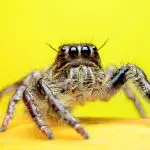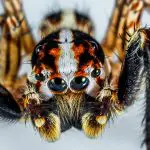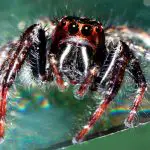Last updated on February 1st, 2023 at 10:04 am
Welcome to our Regal Jumping Spider Care sheet! You can learn everything need to know about their captive care right here…
The Regal Jumping Spider is a low-maintenance but highly entertaining pet. In fact, getting just a few things right can give you a lively pet that is fascinating to watch. Let’s take a look at their enclosure, diet, temperature and water requirements to help you get started.
Regal Jumping Spider size
While the Regal Jumping Spiders are stunning to look at, they are nowhere near as big as tarantulas. This is a small, flighty spider that will take up very little room in your home, but their personality will definitely make a big impact.
It is important to handle the spider carefully and use caution when taking it out of its enclosure. It’s small size means that it is easily injured. You should let it walk on you, rather than try to grab it or stroke it.
The life span of the Regal Jumping Spider is very short, at only two years maximum. Their short lifespan means they shed their skin a lot, usually five to six times during their young and adulthood.
While they are prone to contracting diseases, they have a friendly temperament and tend to bond with their owners. Keeping one in your home will also give you the opportunity to learn more about jumping spiders as a whole, who are an incredibly successful spider family.
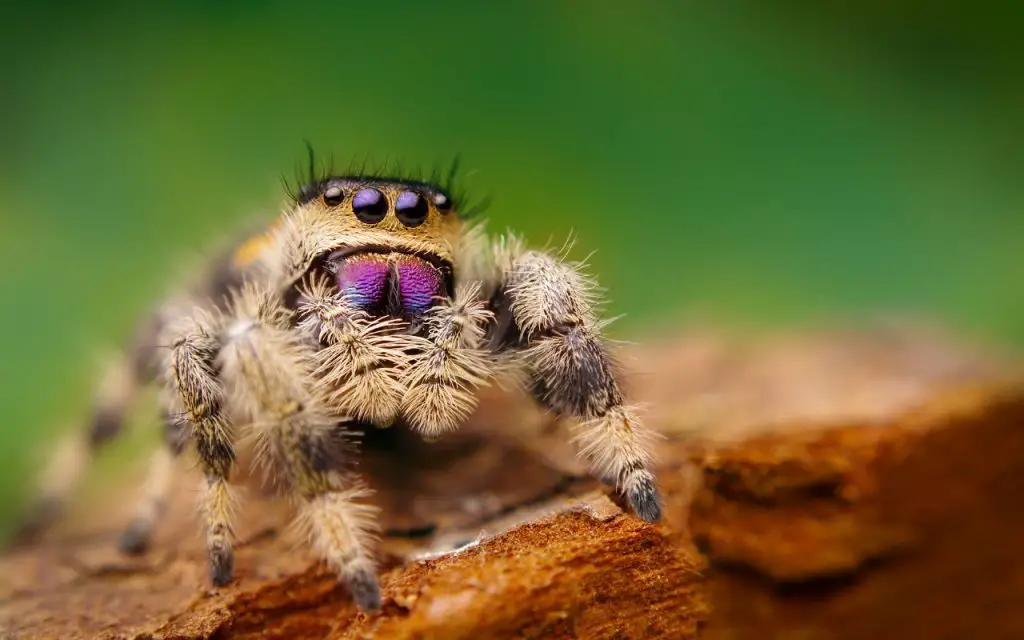
Regal Jumping Spider enclosure
The temperature in the Regal Jumping Spider’s habitat is usually around 30C, with a relative humidity of seventy-five to eighty percent. Because they are adapted to the temperature and humidity changes in their natural habitat, the ideal temperature and humidity for the cage should be between twenty-four and twenty-eight degrees Celsius.
The humidity level in the enclosure should be fifty-five to sixty percent, and you can maintain the temperature by spraying with water regularly.
The cost of keeping a jumping spider is minimal compared to other types of exotic pets. You can easily make their habitat with your own hands, or you can purchase ready-made enclosures. It should also be lined with a substrate that can help maintain a healthy humidity level, like coco coir (Eco Earth).
Adding a few dollars to the total cost of your pet’s housing is well worth the small investment. The food will last you for months, and you can always culture more if needed. The enclosure itself can be made from any container, as long as it’s high enough.
Overall, the most attractive enclosures are specially designed perspex ones that are usually used for arboreal tarantulas. That said, large glass jars work just as well. Whatever type of enclosure you use, just make sure that it is taller than it is wide, and that the lid has adequate ventilation.
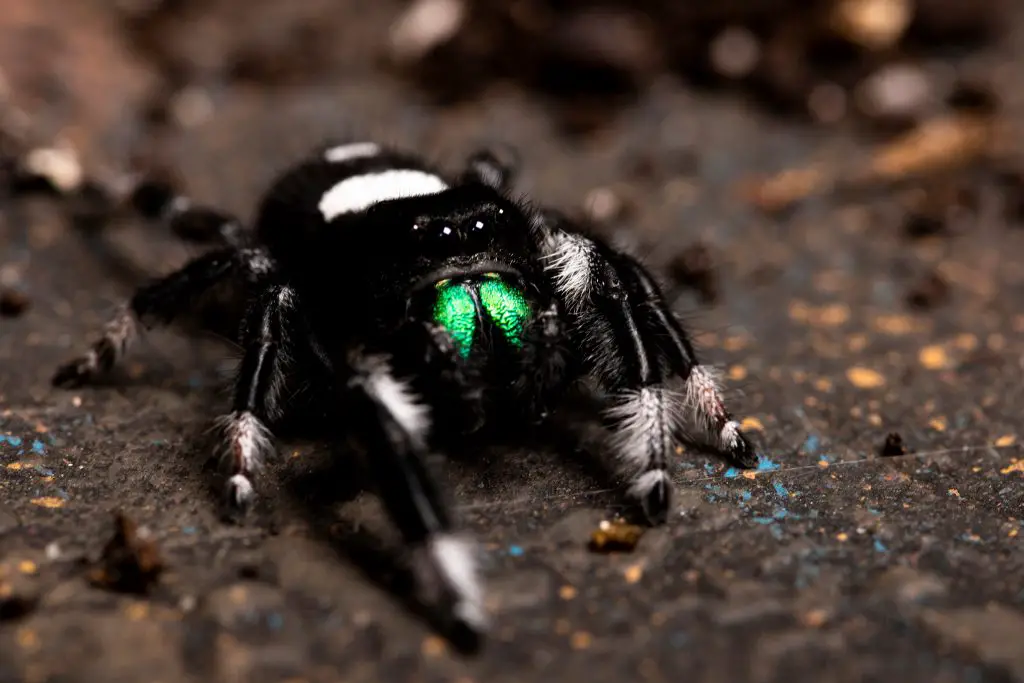
Diet
When caring for the Regal Jumping Spider, remember that they are carnivores. They must be fed insects, so their diet is live. Juveniles should be fed pinhead crickets and flightless fruit flies until they have grown large enough to feed on larger insects. Once adults are grown, they can be fed larger insects, and they should be fed as a decent sized prey item at least once a week.
Though a varied diet isn’t essential for this species, it is worth noting that it is an intelligent hunter. Providing different types of prey when possible may provide enrichment for it and prevent boredom. In fact, they’re very capable predators, and one wild Phidippus regius was even observed eating a frog.
For spiderlings, make sure you offer them food every couple of days, as they grow faster and need to eat more often than adults.
Other acceptable prey items include:
- confused flour beetle larvae
- young Dubia roaches
- regular fruit flies
- other fly larvae
Remember that according to some studies, baby jumping spiders won’t eat for at least 5 days after hatching. If you’d like to learn more, one such study is: The role of experience in the development of predatory behaviour in Phidippus regius, a jumping spider (Araneae, Salticidae) from Florida
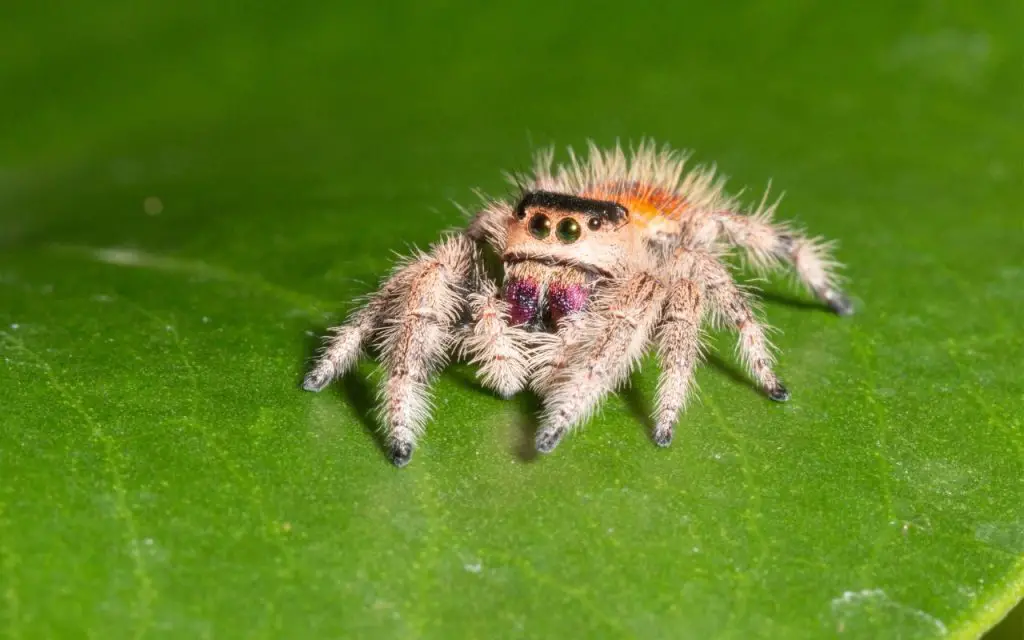
Heat
The most healthy temperature for the Regal Jumping Spider in captivity is around 24°C (warm room temperature). It should be maintained between 50-60% humidity.
Regal Jumping Spiders are hardy creatures that are capable of adjusting to extreme changes in temperature and humidity. In their natural habitat, the spiders can survive in temperatures up to 30C and over. Nonetheless, in captivity shouldn’t keep them this warm. This is because in an enclosure they have less room to move to somewhere cooler if they feel too warm.
Though the temperature can vary a little, constant water supply is essential. Lack of water and inadequate spraying can lead to dehydration. Moreover, you should have a digital thermometer and monitor the temperature of your pet’s enclosure.
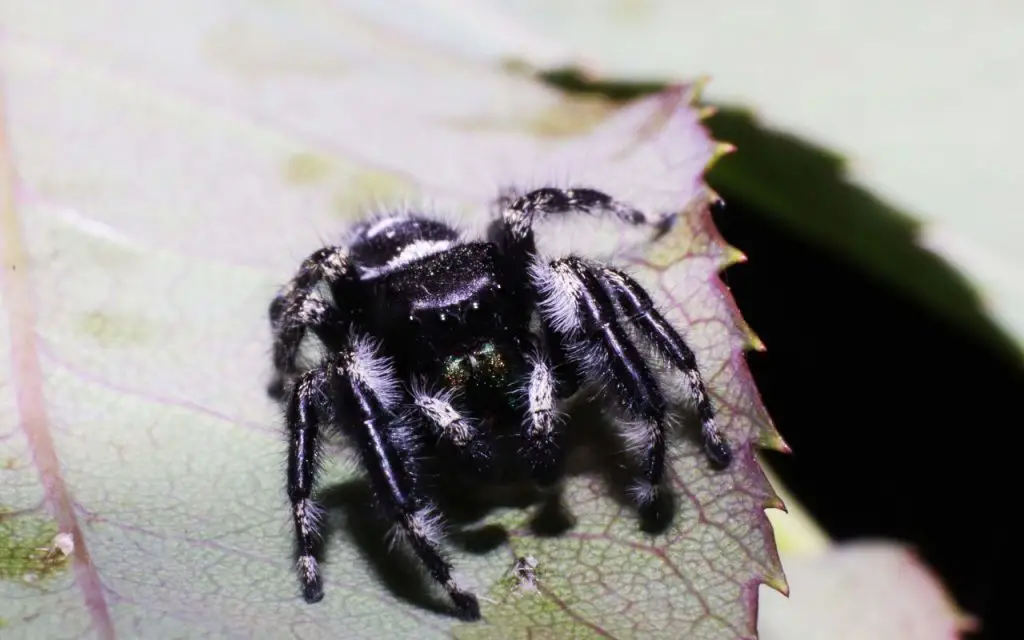
Water and humidity
Its habitat is an open area with temperatures around 30C and relative humidity of 75-80%. These conditions are ideal for this species, which adapts well to changes in temperature and humidity.
You don’t have to provide such high humidity in captivity, as these conditions can lead to mold growth in its enclosure. Instead, aim for 50-60% humidity and spray the cage with water daily to keep the it stable.
Spraying the enclosure also provides drinking water for the spider, as it will drink droplets off of surfaces.
During the winter season, the temperature in its cage should still be at least 70F/20C. However, be cautious of using damp paper towels or cloths to clean the substrate. Do not use sponges, as these may harbor bacteria that are harmful to the jumper.
Moreover, it is important to keep the enclosure away from direct sunlight, as this can cause overheating. Aside from keeping it out of direct sunlight, using an analog humidity gauge is a good way of monitoring it.
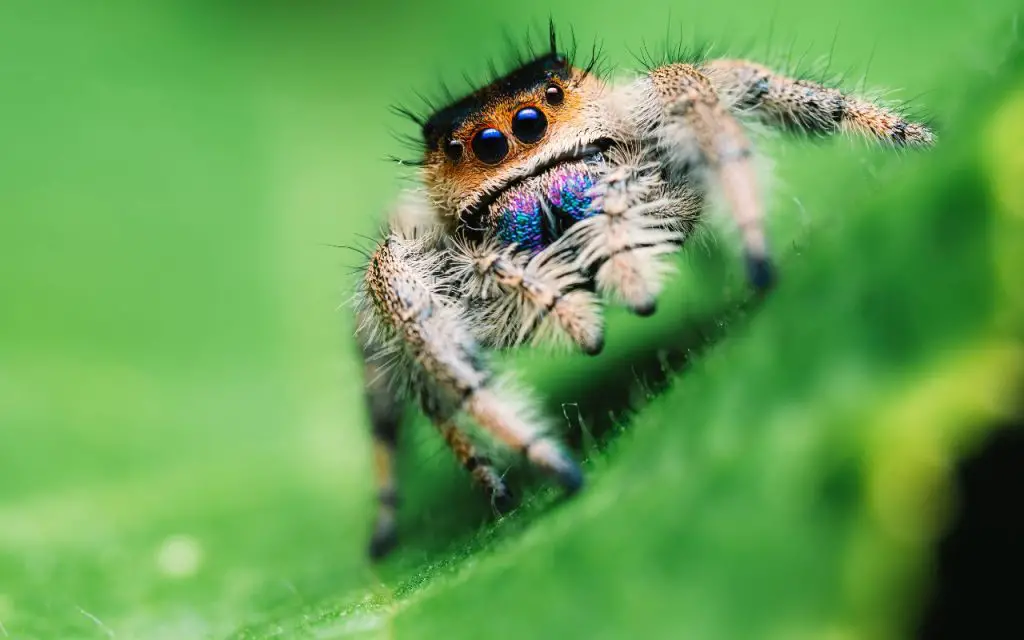
Regal Jumping Spider male vs female
Despite the adorableness of regal jumping spiders, the males do have distinctive warning colors that make them look frightening to other animals. They dance to attract females and impressive to look at with their black and white banding, and bright green chelicerae.
Females are brown instead of black, and look a little less bright. They are still incredibly beautiful, however, having shiny purple chelicerae instead.
If you’re planning on raising a regal jumping spider as a pet, you’ll have to know the basic differences between the sexes. Females are slightly larger than males, between 0.28 and 0.87 inches.
While males are thinner and have thicker forelegs, females are fatter and generally darker in color. Regal jumping spiders are among the largest species of Jumping Spiders, and their coloration is striking when they reach maturity.
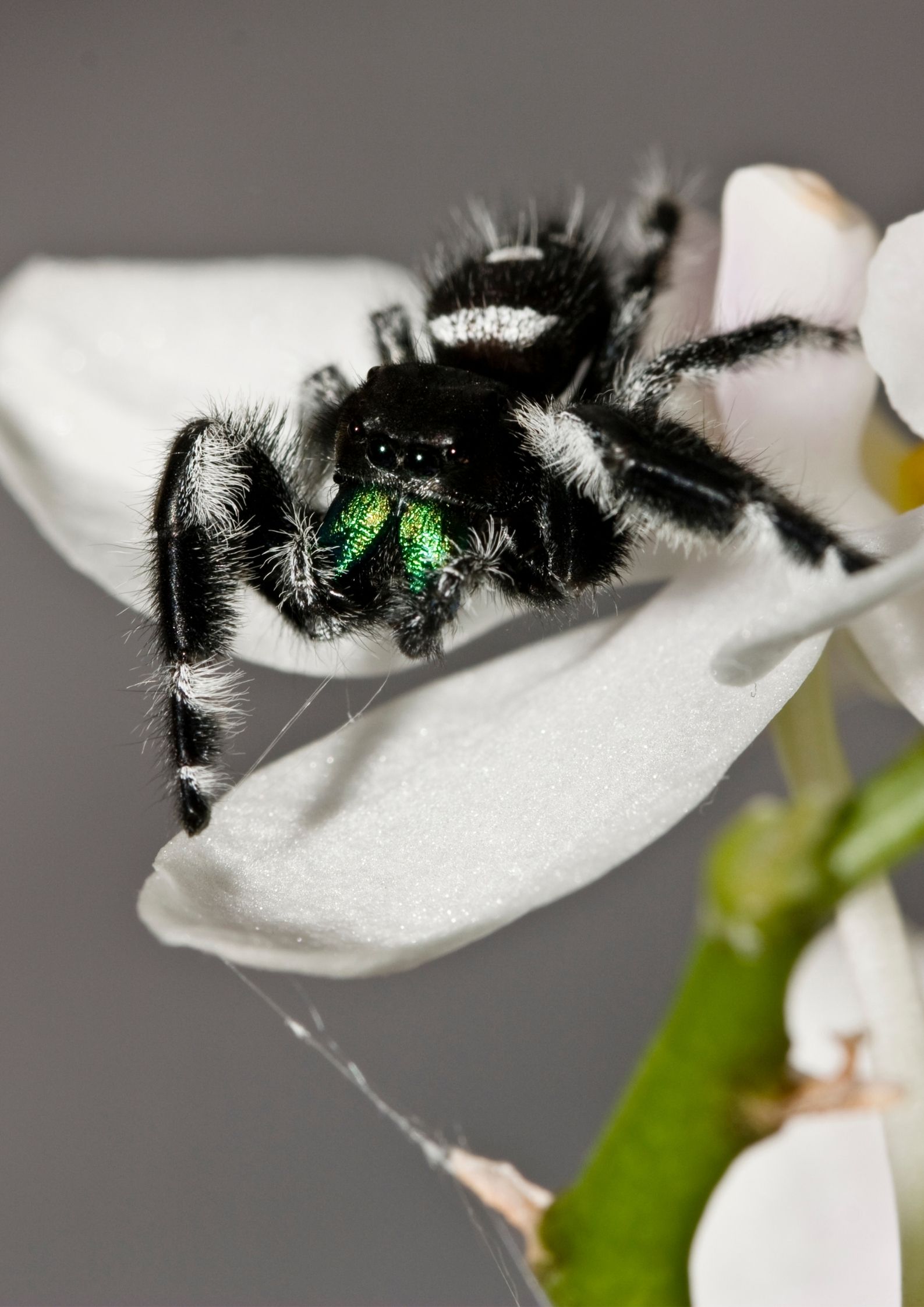
Regal Jumping Spider lifespan
The lifespan of the regal jumping spider is not long. It may be less than ten months when it is in the wild, but it can live for two years in captivity.
Overall, this spider’s temperament is well-balanced and friendly. It is curious and loves to explore its enclosure, meaning that it will give you a lot of entertainment even if it is not very long-lived.
The lifespan of the regal jumping spider is short compared to mygalomorphae spiders like tarantulas and trapdoor spiders. Notwithstanding, it has a lot going for it and is a great choice for a first arachnid pet.
Its size is 3.5-inches long, which is around three-fifths of its body length. Because it does not require a lot of space in your home, you can safely house it in your bedroom or office in just a large jar.
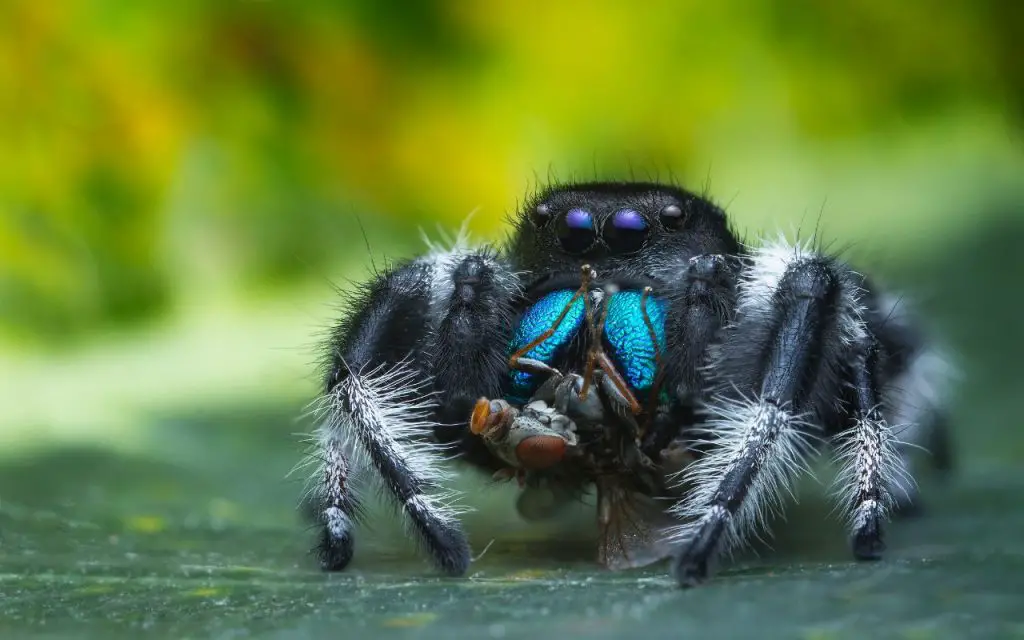
Regal Jumping Spiders for sale
If you’re thinking about getting a Regal Jumping Spider, there are several considerations that you need to consider before you buy. These animals need an enclosure that is secure, breathable, and easy to clean.
Phidippus regius is one of the most common types of jumping spiders, and generally the most widely available as a pet. This species is easy to care for, requires little maintenance, and exhibits striking colors.
Its huge beady eyes make it a great pet for beginners. The Phidippus Regius is a visual hunter, active during the day and sleeping at night. It is also sexually dimorphic, and exhibits an abundance of colorful markings on its body.
If you want to buy one, try joining specialist forums, or social media groups. Some websites aslo sell them on occasion, like Josh’s Frogs and Morphmarket.
Summary and quick facts
| Care level: | Beginner |
| Temperament: | Friendly, inquisitive |
| Common names: | Regal Jumping Spider, Regal Jumper |
| Scientific name: | Phidippus regius |
| Range: | south-eastern US, Bahamas, Antilles |
| Temperature: | 24C ideal |
| Humidity: | 50-60% |
FAQ relating to Regal Jumping Spider care
How do you take care of a regal jumping spider?
To take care of a Regal Jumping Spider, your first step is to get it a secure, safe enclosure that has some ventilation holes or mesh so it can breathe. Then, you need to make sure it will be somewhere warm, but out of direct sunlight, and provide it with appropriate food, water, and climbing opportunities. You can learn about all of this and more in this care sheet.
What do you feed a regal jumping spider?
Regal Jumpers eat a wide variety of bugs in the wild. In captivity, however, you should feed them feeder insects that we know are safe and unlikely to fight back too much. These include flour beetle larvae, baby Dubia roaches, and fruit flies – all of which are available online or in pet stores.
How long do regal jumping spiders live in captivity?
Regal Jumping Spiders can live for as long as two years in captivity. This isn’t as long as larger arachnides, like tarantulas, but isn’t bad either when you consider how small they are. To give your spider the longest possible lifespan, always pay close attention to how warm and humid it is. Low humidity can quickly be fatal.
How often do you feed Regal jumping spiders?
Adults should be fed once or twice a week and babies should be fed every day or every other day. Don’t worry about overfeeding them – jumping spiders only eat what they need. They also avoid poisonous prey if ever you give them something you shouldn’t have, so that isn’t an issue either. If bugs remain in the enclosure, you can always remove them and try again in a day or so.

